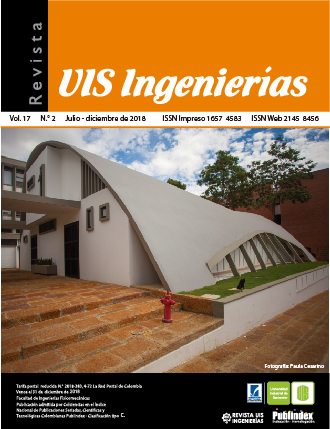Publicado 2018-06-12
Palabras clave
- Biofluidos,
- carina,
- dinámica de fluidos computacional
Cómo citar
Resumen
El efecto del radio de redondeo de la carina durante el proceso de inhalación es explorado numéricamente mediante simulaciones computacionales basadas en un modelo sintético de vías respiratorias. Las geometrías son parametrizadas en términos de la curvatura adimensional de carina. En el presente estudio se exploraron dos números de Reynolds en régimen laminar. Los resultados obtenidos muestran que la variación de este parámetro fisiológico afecta la magnitud y distribución de los esfuerzos cortantes de pared, así como el comportamiento de las estructuras vorticales observadas en el flujo secundario. Este parámetro afecta también, aunque en menor medida, las caídas de presión a través de las ramificaciones. Igualmente se discuten algunos efectos producidos por la variación de dicha curvatura sobre aspectos fisiológicos del proceso de respiración. Finalmente, se hace una breve reflexión acerca de las ventajas del uso de técnicas de simulación computacional CFD para el estudio de fenómenos asociados a biofluidos.
Descargas
Referencias
Lee, D., Park, S. S., Ban-Weiss, G. A., Fanucchi, M. V., Plopper, C. G. and Wexler, A. S. “Bifurcation model for characterization of pulmonary architecture”, The Anatomical Record, vol. 291, no 4, p. 379-389, 2008.
Kang, M. Y., Hwang, J. and Lee, J. W. “Effect of geometric variations on pressure loss for a model bifurcation of the human lung airway”, Journal of biomechanics, vol. 44, no 6, p. 1196-1199, 2011.
Schroter, R. C. and Sudlow, M. F. “Flow patterns in models of the human bronchial airways”, Respiration physiology, vol. 7, no 3, p. 341-355, 1969.
Liu, Y., So, R. M. C. and Zhang, C. H. “Modeling the bifurcating flow in a human lung airway”, Journal of biomechanics, vol. 35, no 4, p. 465-473, 2002.
Comer, J. K., Kleinstreuer, C. and Zhang, Z. “Flow structures and particle deposition patterns in double-bifurcation airway models. Part 1. Air flow fields”. Journal of Fluid Mechanics, vol. 435, p. 25-54, 2001.
Chu, C. P. W. and Chen, P. P. “Tracheobronchial injury secondary to blunt chest trauma: diagnosis and management”. Anaesthesia and intensive care, vol. 30, no 2, p. 145, 2002.
Van Ertbruggen, C., Hirsch, C. and Paiva, M. “Anatomically based three-dimensional model of airways to simulate flow and particle transport using computational fluid dynamics”, Journal of applied physiology, vol. 98, no 3, p. 970-980, 2005.
Haskin, P. H. and Goodman, L. R. “Normal tracheal bifurcation angle: a reassessment”. American Journal of Roentgenology, vol. 139, no 5, p. 879-882, 1982.
Sahni, D., Batra, Y. K. and Rajeev, S. “Anatomical dimensions of trachea, main bronchi, subcarinal and bronchial angles in fetuses measured ex vivo”. Pediatric Anesthesia, vol. 18, no 11, p. 1029-1034, 2008.
D'Souza, A., Ankolekar, V. H., Das, A., Padmashali, S., D’Souza, A. S. and Mamatha, H. “Determination of inter-bronchial and subcarinal angles in fetuses of different gestational age and their clinical implication”. Muller Journal of Medical Sciences and Research, vol. 6, no 2, p. 129-132, 2015.
West, J. B. “Respiratory physiology: the essentials”. Lippincott Williams & Wilkins, MLA. 2012
Weibel, E. R. “Geometric and dimensional airway models of conductive, transitory and respiratory zones of the human lung”. Morphometry of the human lung. p. 136-142, 1963.
Horsfield, K., Dart, G., Olson, D. E., Filley, G. F.and Cumming, G. “Models of the human bronchial tree”. Journal of applied physiology, vol. 31, no 2, p. 207-217, 1971.
Zhao, Y. and Lieber, B. B. “Steady inspiratory flow in a model symmetric bifurcation”, Transactions of the ASME-K-Journal of Biomechanical Engineering, vol. 116, no 4, p. 488-496, 1994.
Calay, R. K., Kurujareon, J. and Holdo, A. E. “Numerical simulation of respiratory flow patterns within human lung”, Respiratory physiology & neurobiology, vol. 130, no 2, p. 201-221, 2002.
Yu, G., Zhang, Z. and Lessmann, R. “Computer simulation of the flow field and particle deposition by diffusion in a 3-D human airway bifurcation”, Aerosol Science and Technology, vol. 25, no 3, p. 338-352, 1996.
Xia, G., Tawhai, M. H., Hoffman, E. A. and Lin, C. L. “Airway wall stiffening increases peak wall shear stress: a fluid–structure interaction study in rigid and compliant airways”, Annals of biomedical engineering, vol. 38, no 5, p. 1836-1853, 2010.
Dailey, H. L., Yalcin, H. C. and Ghadiali, S. N. “Fluid-structure modeling of flow-induced alveolar epithelial cell deformation”, Computers & structures, vol. 85, no 11, p. 1066-1071, 2007.
Sidhaye, V. K., Schweitzer, K. S., Caterina, M. J., Shimoda, L. and King, L. S. “Shear stress regulates aquaporin-5 and airway epithelial barrier function”, Proceedings of the National Academy of Sciences, vol. 105, no 9, p. 3345-3350, 2008.
Pedley, T. J., Schroter, R. C. and Sudlow, M. F. “The prediction of pressure drop and variation of resistance within the human bronchial airways”, Respiration physiology, vol. 9, no 3, p. 387-405, 1970.

